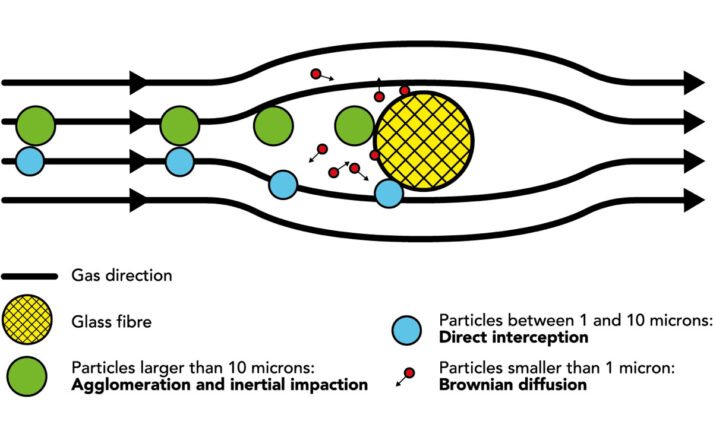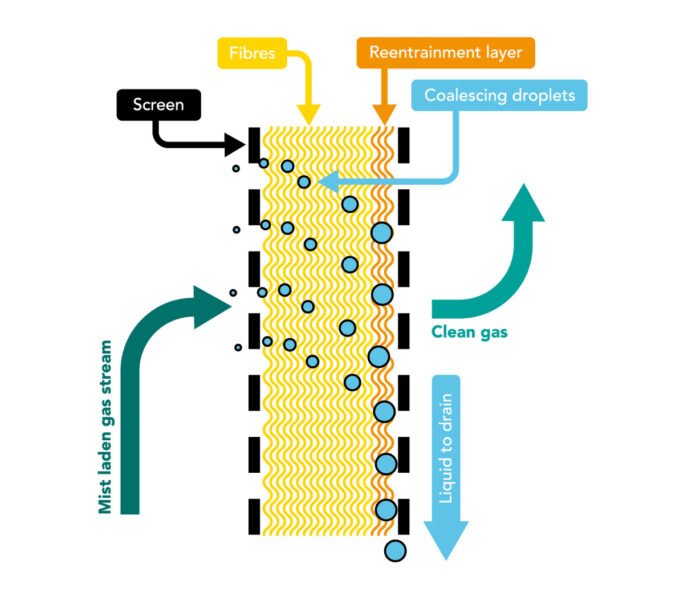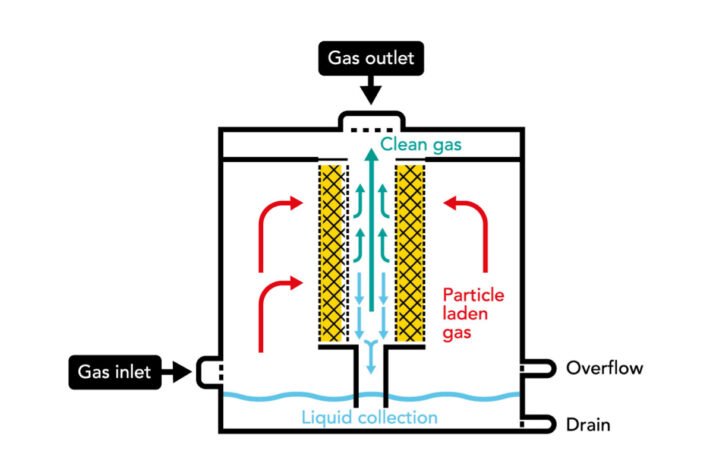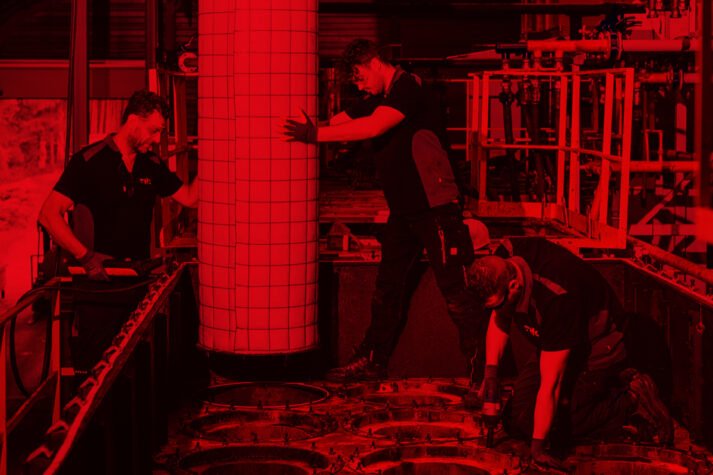Atephos mist eliminators
Working principle
The gas is fed horizontally through a glass fibre bed. Particles are set in contact and collected on individual fibres of the bed and then coalesce to form liquid films and droplets. This liquid is transported through the bed by the gas flow. The collected liquid is then drained from the downstream face of the bed by gravity.
The particles are collected in three different ways: by agglomeration and inertial impaction, mainly for particles larger than 10 micron, by direct interception for particle sizes between 1 and 10 micron, and by Brownian diffusion for particles smaller than 1 micron.
Mist collection mechanism
ATEPHOS Mist Eliminators can be designed to achieve collection efficiencies of more than 99.5 % and this at pressure drops in the range of 500 to 2500 Pa.
Typical gas flow arrangement
Fabrication
ATEPHOS Mist Eliminators are custom made in our EFC workshop.
Existing Mist Eliminators from other manufacturers can be regenerated with new Fibre Beds in our EFC workshop.
Based on the application, process conditions, efficiency needs, pressure drop requirement and gas flow, the type and characteristics of the specific ATEPHOS Mist Eliminator is designed.
Expertise, Fibre Quality, Fibre Bed Velocity, Fibre Bed Density and Fibre Bed Thickness are important parameters to achieve predicted performance.
The filter cages are manufactured in different types of material such as: any weldable metal as 316 SS, 304 SS, Titanium or Plastics as FRP, PVC, PVDF, and Polypropylene.
ATEPHOS Mist Eliminators are produced according Industry Standards and are interchangeable with Mist Eliminators made by other manufacturers.
Use of EFC ATEPHOS
- To prevent Air Pollution.
- To stop downstream Equipment Corrosion.
- To improve final Product Quality.
- To reduce loss of Valuable Product.
- To reduce Maintenance Downtime.
Typical Applications
Ammonium Nitrate
The gas is fed horizontally through a glass fibre bed. Particles are set in contact and collected on individual fibres of the bed and then coalesce to form liquid films and droplets. This liquid is transported through the bed by the gas flow. The collected liquid is then drained from the downstream face of the bed by gravity.
Asphalt Manufacturing / Storage / Loading
To capture Asphalt vapours which would otherwise condensate in air and cause a visible plume and an unacceptable hydrocarbon emission with serious health hazards.
Compressed Gas
To prevent fouling and damaging instruments and equipment with oil and water mists ATEPHOS Mist Eliminators are installed.
Chlorine
ATEPHOS Mist Eliminators are installed on the Wet side to prevent fouling of the drying tower, and reduce sulphuric acid consumption. ATEPHOS Mist Eliminators are installed after the drying tower to protect downstream equipment from acid mist corrosion.
Food Industry
Fried Food preparation, elimination of frying oil mists. Peanut and Coffee roasting oil removal.
Nitric Acid
To prevent expensive catalyst loss and to optimise the production process ATEPHOS Mist Eliminators are installed on different Nitric Acid production stages. For Platinum recovery, Air and Ammonia Filtration.
Metal Workshops
Reduce housekeeping problems by removing the blue smoke which is formed when metal parts are cooled with lubrication fluids. In milling, rolling, drilling and metal shaping operations.
Phosphoric Acid
ATEPHOS Mist Eliminators are installed for air pollution control purposes.
Plastic Manufacturing
To capture plasticizer vapours from ovens curing vinyl coated flooring or wallpaper, to eliminate visible plume.
Printing Industry
Web offset press dryer emissions, printing oils and solvents used in web offset printing cause pollution problems and if captured have a high heating value and may be used as substitute heating oil.
Sulfonation
To increase product purity and reduce air pollution problems acid mists are captured with ATEPHOS Mist Eliminators.
Sulphuric Acid / Oleum Storage / Loading
Acid mist causes corrosion problems on downstream equipment, fouls catalyst, causes air pollution problems when emitted to the atmosphere and creates safety problems in the loading area. Typical locations for ATEPHOS Mist Eliminators are:
- Drying Towers
- Interpass Absorbers
- Final Absorbers
- Cross Flow Stripper
- Oleum Tanks Loading Stations
- Product Stripper
- SO2 scrubber off gas
Textiles Industry
Emissions from tenter frame ovens cause a blue haze.
Urea
ATEPHOS Mist Eliminators reduce the product loss and the environmental impact of Urea production.





